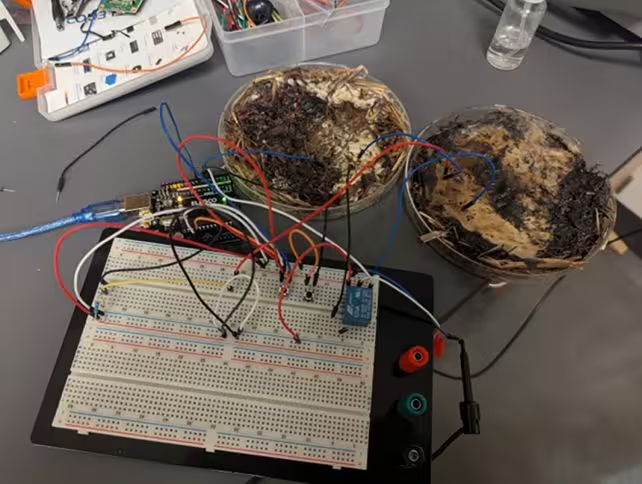5 Minutes
Researchers have turned a familiar culinary fungus into a functioning computer element: shiitake mycelium can act as a memristor — an electronic device that remembers past electrical states. This early proof-of-concept suggests a path toward low-cost, biodegradable, and energy-efficient memory hardware built from living networks rather than silicon.
Fungi as hardware: what a memristor does and why mycelium matters
Memristors are circuit components that change their electrical resistance based on the history of current that has flowed through them, making them ideal analogs for synapses in neuromorphic computing — systems designed to mimic how the brain processes information. Unlike transistors, memristors can retain a memory of previous signals without constant power, enabling devices that consume less energy in standby and that can perform brain-like tasks more efficiently.
Mycelial networks, the fibrous root-like structures of fungi, naturally transmit electrical and chemical signals and form complex, adaptive networks. Those properties have attracted attention from engineers and neuroscientists seeking materials that can emulate biological synapses. Shiitake (Lentinula edodes) is especially attractive: it grows robustly, resists environmental stressors such as radiation, and can be cultured affordably at scale.
How the experiment worked
In the study, researchers inoculated nine petri dishes with shiitake spores in nutrient substrate and let the mycelium grow under controlled temperature and humidity. Once the mycelial mat covered the dish, samples were dried in well-ventilated areas under sunlight to stabilize them for electrical testing. The prepared samples were then wired into custom circuits and probed at multiple points, because different regions of the mycelium exhibited distinct electrical properties.
The team varied voltages and connectivity to map how the fungal material responded. By monitoring current and resistance changes over time, they observed memristive behavior — the hallmark of a component that ‘‘remembers’’ prior electrical states. Engineers often build memristors from metal oxides or nanoscale silicon structures; demonstrating similar behavior in biological tissue opens a new materials class for bioelectronics.

The mycelial memristors connected to a circuit. (LaRocco et al., PLOS One, 2025)
Performance, trade-offs, and early results
The team reported switching at about 5,850 Hz with roughly 90% accuracy in their experimental setup — meaning the fungal memristor could change state nearly 5,850 times per second. That rate is slower than the fastest commercial silicon memristors but comparable to the lower end of real-world devices, and it is remarkable for a first-generation biological device.
Researchers also found that higher applied voltages degraded performance; one mitigation was to add more mycelial elements to the circuit to distribute load and stabilize behavior. Biological variability and environmental sensitivity are clear challenges. Unlike manufactured chips, living matter can be inconsistent between samples, and long-term stability requires careful processing and packaging.
Why this matters: sustainability and accessibility
Fungal memristors could offer advantages where low cost, biodegradability, or ease of cultivation matter. Imagine sensors in remote environments built from compostable electronics, or educational kits that let students build simple bioelectronic circuits in a classroom. In constrained situations such as spaceflight or austere field deployments, the ability to grow and repair computing elements on-site could reduce reliance on supply chains.
At the same time, these devices are unlikely to replace mainstream silicon chips in consumer smartphones anytime soon. Instead, fungal bioelectronics could carve out niches in neuromorphic research, environmental sensing, and applications where energy efficiency and circular-materials approaches are prioritized.
Future directions and research steps
Next steps include improving reproducibility, scaling device architectures, and integrating mycelial memristors with conventional electronics. Researchers will also test longevity, tolerance to humidity and temperature fluctuations, and potential methods for hybridizing fungal tissues with printed circuit platforms. This terrain intersects materials science, synthetic biology, and electronic engineering, and progress will depend on interdisciplinary teams.
Expert Insight
"The appeal of mycelium-based memristors is not that they will immediately outperform silicon, but that they expand the palette of materials engineers can design with," says Dr. Elena Cruz, a hypothetical bioelectronics engineer. "If we can tame variability and package these materials, they could enable low-power neuromorphic nodes and truly circular electronic components."
With research published in PLOS One and fielded by teams exploring fungi and computing, the phrase from the authors — "The future of computing could be fungal" — now reads less like hyperbole and more like an invitation: to test, adapt, and imagine computing technologies that are grown instead of fabricated.
Source: sciencealert
Comments
skyspin
Is this even true? sounds neat but living circuits feel fragile. how long before mold or drying ruins it, and can they really scale?? idk
bioNix
wait what? shiitake as memory hardware... wow. cool but kinda eerie, imagine compostable chips, also what about bugs and humidity lol


Leave a Comment